Botanical Illustration: Cheating doesn’t exist
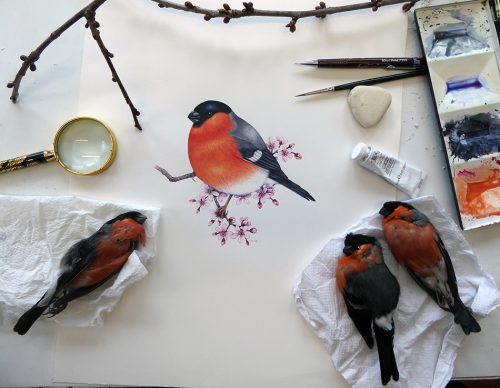
Cheating
When I chat to people who are just beginning botanical illustration, I quite often get questions about whether or not certain things are “cheating”. This annoys and upsets me. Everyone should be encouraged to draw and paint, and to use whatever tools are available to them.
There seems to be a strange idea that various shortcuts , tools, and techniques which are incredibly helpful to a botanical illustrator are somehow “cheating”. I want to try and dispel some of these ideas. By so doing I hope to encourage beginners to draw and paint plants and flowers without any unnecessary feelings of guilt or shame. (For more on drawing for the absolute beginner, check out my blog.)
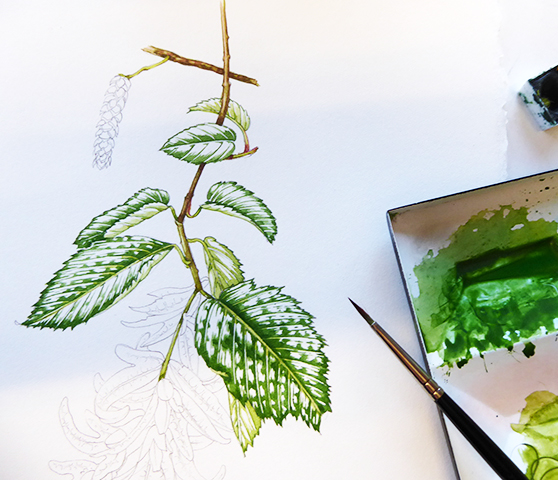
Hornbeam Carpinus betulus
Drawing around things
Quite often, students and beginners are challenged by trying to record the shape of a leaf or flower. So they draw around the object, then fill it in.
I have no real problem with this, it provides a pretty decent map with elements in good proportion to one another.
If they do this then they can concentrate on the internal structures and the veins and patterns of a flower and leaf.
I wouldn’t recommend it as a teaching technique as it doesn’t help teach you to translate a three-dimensional object into a two-dimensional object, and because drawing round an object doesn’t allow for structural elements like foreshortening or curved surfaces.
However, I’m not going to forbid it either. It can be useful for flat objects, and in my time I’ve been known to draw around fronds of a fern to figure out how they relate to each other, when recording the structure itself was doing my head in.
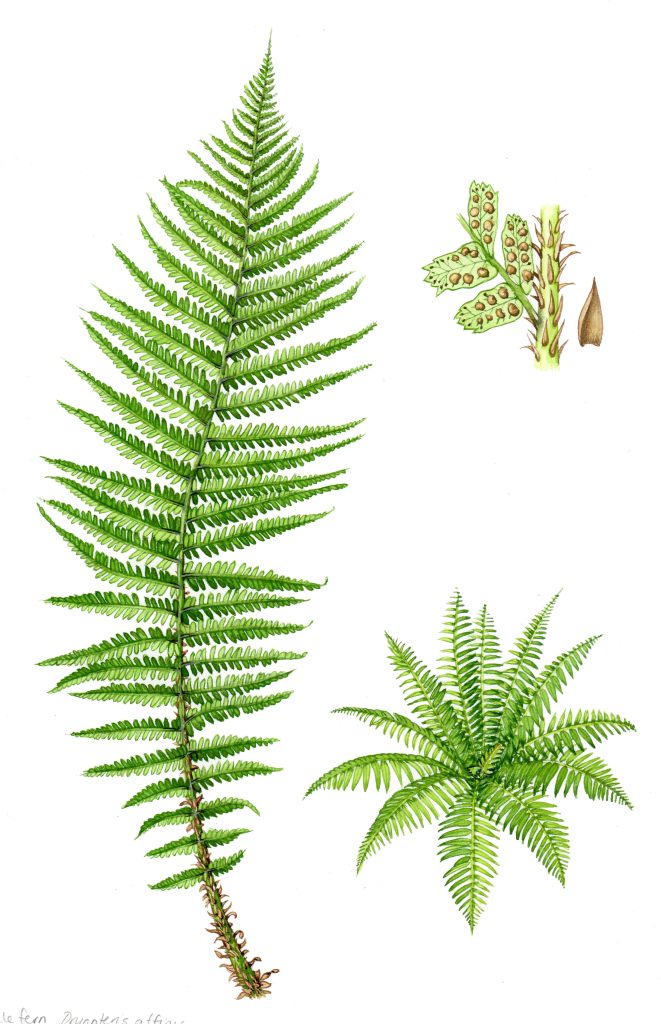
Scaly male fern Dryopteris affinis
So is drawing around things cheating? Well, it may be of limited usefulness, but no, it’s not cheating.
Using photos
Photographs are an incredibly useful resource. I have no issue at all with people using them for reference, or to work from.
A photo does some of the hard work for you, flattening a three-dimensional object to a two-dimensional one. It records darks and lights onto a surface in a way that may be easier than trying to plot these differences by looking at a specimen.
Photos have their drawbacks. The colours on a photo may not be true to life. It’s much easier to figure out the structure of a plant or animal if you have it in front of you, than if it’s flattened. This is because a real plant or flower can be turned. It can’t be looked at from another angle. Alas, a photo cannot be.
One other really important point about using photos is you must get permission of the photographer before using the photo. If you don’t you’re infringing their copyright. This is not only a bit rude, but also illegal.
I frequently use photographs (see my blog on this for more).
Without photos there’s no way I could complete an illustration of a plant which wasn’t in flower. Photos back up my sketchbooks. They add to information of plants I gather from text books and other illustrators’ works. I have metres of catalogued photos of plants that I’ve taken, and I refer to these constantly.
Photos allow you to combine different stages of a plant’s life, you can add a rosehip to a painting of a rose without having to wait for four months for the rosehip to develop and ripen. Sure, it’d be lovely to wait for the rosehip to appear, but with deadlines and the understandable desire to get a painting “done”, it’s often a luxury we free-lancers (and beginners) can’t afford.
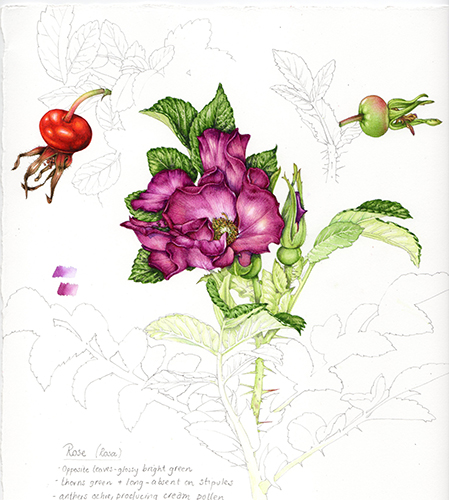
Rosa rugosa
Is using photos cheating? If you can’t get your hands on the actual plant itself then what better resource than a photo? No, in my opinion using photos is not cheating.
Using projectors
In my studio I have an extremely well-used and invaluable piece of kit. It’s called a “Design master II” projector, and I can’t begin to tell you how many hours of my time it’s saved. You pop an image into the top section of it, and can shrink or enlarge the image which is projected onto the table below. Draw around the image and hey presto! Done.
I find my projector especially useful when I’m building up composite landscapes. If I’ve been given a list of 35 species to pop into a habitat, it’s invaluable. Getting them to scale would take months if I couldn’t shrink and enlarge them.
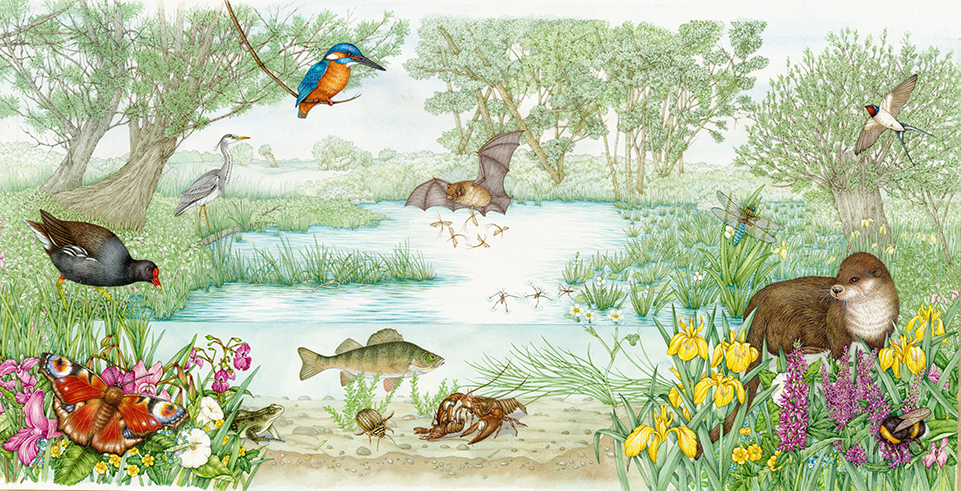
Woodstock water meadow
Using a projector may not be something many beginners do. Often when I mention this tool, people often ask me if it’s not “cheating” to use it.
David Hockney explores this question in his fascinating book; Secret Knowledge: Rediscovering the Lost Techniques of the Old Masters. In this book he examines how many of the great masters used whatever optical tools they had available to construct their paintings. Artists such as Caravaggio, Jan Eyck, Vermeer, Ingres, Warhol and Cezanne used mirrors, the camera obscura, projectors, and lenses to help them with their work. (See the Guardian’s book review for more.
Hockney regards the artists who used these tools as rather intelligent, and so do I. Why would you choose to eschew a technique or tool that simplifies your life and saves you time?
So no, I do not regard using a projector as “cheating”.
Tracing
Another useful technique which is sometimes labelled as “cheating” is the use of tracings. Again, I want to assure anyone who traces their work that this is totally acceptable, and something that almost everyone within the botanical illustration community does.
There are different reasons for tracing. I use it if I’m illustrating butterflies or beetles. Although there are individual variations between butterfly wings, if you get one side of a butterfly drawn up, then trace and flip the trace to complete the illustration, you’ve found a good time-saving technique. Once drawn up, you can re-examine the minute differences between the two sides and edit your drawing accordingly.
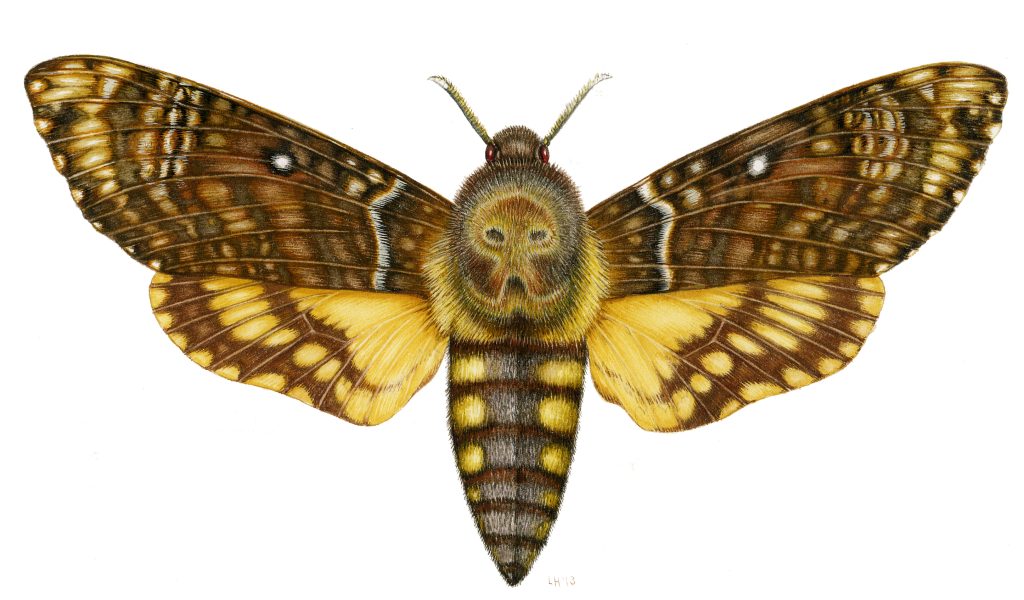
Deaths head hawkmoth Acherontia atropos
Many botanical illustrators will draw up their subject, then use tracing to transfer it to the final surface they’ll be painting on. It means the working drawings can be kept away from pristine fresh paper, and that any mistakes can be fixed at an earlier stage.
Is it cheating? I can’t see how. It looks like good management to me.
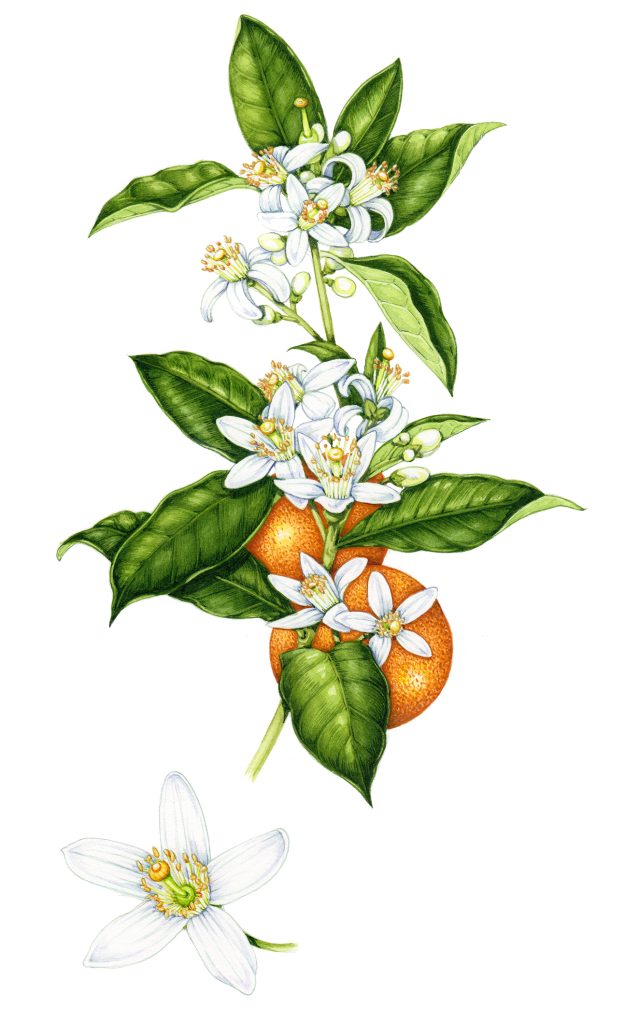
Sweet orange Citrus sinensis
What is cheating?
The Oxford English dictionary defines cheating as: “Acting dishonestly or unfairly in order to gain an advantage.”
I can’t see how using helpful tools, modern technology, and tried and tested techniques can be seen as “dishonest” or as getting anyone an “unfair advantage”. Everyone has access to these things, and should be encouraged to use them as they see fit.
Is using a magnifying glass or dissecting microscope “cheating”? It’s another use of lenses. Is working from dead birds stored in the freezer “cheating”? I’m not sure how doing this differs from using a photo (except that it’s easier to get your hands on a photo of a bullfinch!)
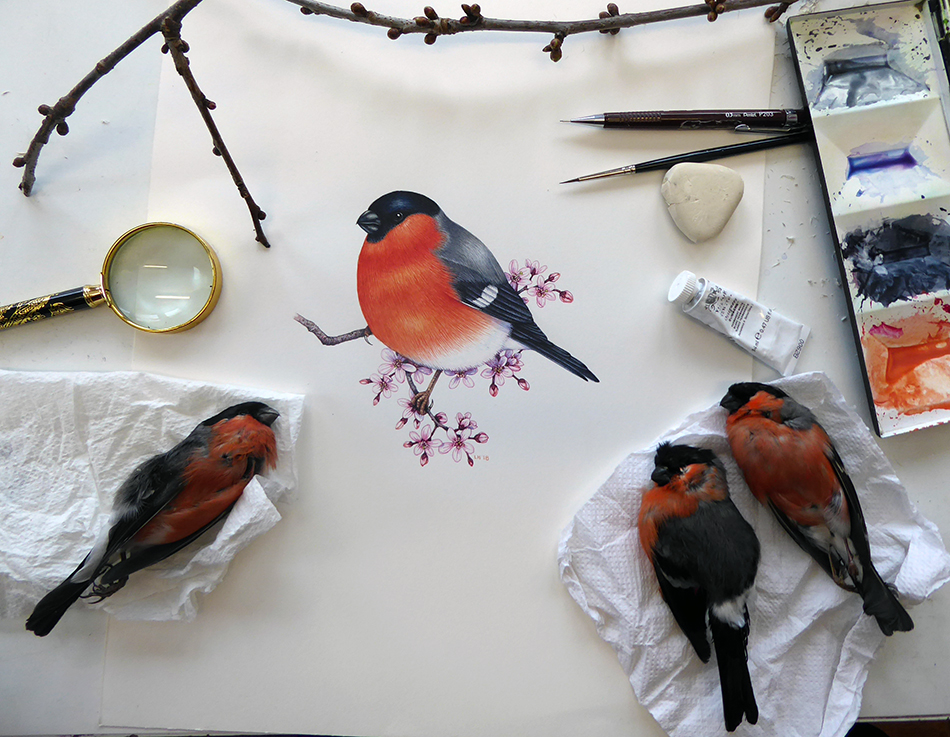
Bullfinch illustration with reference
Why do I get cross when people talk about cheating in art?
My main problem with the use of the word “cheating” is the effect it has on those starting out, on beginners.
If paralyses them. They’re often so afraid that they’re doing it wrong. They fear they’re cheating, that they’re going to be frowned on.
They may not be sure of what is, or what isn’t seen as “cheating”, and simply don’t utilise straightforward approaches to creating art as a result.
I do not believe there is any such thing as “cheating” when it comes to drawing. Whatever tools are available, use them. Whatever techniques seem to help you, practice them.
The only way you hone and improve your drawing and painting skills is by putting in the hours, and by drawing as much as possible. To sustain you you need to feel passionate and inspired by your subjects, encouraged and supported by those teaching you, and you need to feel confident that whatever approach you use, you won’t be chastised for using it.
So please. No more nonsense about cheating. If you love drawing and painting, do it. Use whatever tools you like, enjoy yourself, learn from doing it. And if someone accuses you of cheating, just remember, sharing techniques with Vermeer, Hockney, and Caravaggio puts you in rather good company!


Dear Lizzie Harper,
I’m so glad you wrote this. I started drawing just few weeks ago and needed some help. This help was a photo or some drawing from somebody else.
If we all could get this from our mind it self, we all would name Leonardo Da Vinci. But we are not.
Thank you.
Couldn’t agree more, Davorka. Thanks for the comment, and keep going at the drawing. Whatever you’re doing…it’s right!
Oh thank heavens for you Lizzie. American teachers of botanical art are obsessed with cheating. They do it but don’t admit it and then the students do fall into despair and stop.thank you thank you
I do get a bit cross about the whole “mystique” surrounding the creative processes. I’m not sure why it exists, either. And I think it makes life easier for professionals too to be up front and honest about our techniques. I use a projector quite often, saves me HOURS or scaling drawings up and down. And for ages I kept it quiet, I thought it was cheating. But, like everything else, it’s just a tool to help you get the desired end result.
More transparcy can only help the students who’ve given up time (and money) to try and learn new things. I’m glad my rant of a blog is useful, and keep on drawing, no matter what techniques you use!
Thanks so much for the comment, Lydia.
Thanks for that jolt of honesty. You are not only extremely talented and hard working but a lovely creation of integrity. Hope to some day meet you across the pond.
Wow! That little bundle of compliments will keep me going for quite some time – thank-you so much!
I am so pleased to have read your illuminating article. The comment regards ‘the master’s sums it up nicely. Very helpful..
Hi Ian
Glad you agree, thanks for the comment. And yes, of course the old masters would have used whatever inventions they could get their hands on to make their jobs easier and quicker. I like to think how excited the Rennaissance masters might be to see all the tools available to us today, Im sure they’d never mention cheating!
In the post modern age illustrators began using photographic reference. What could be wrong with this?
I suspect that the idea of ‘cheating’ comes from the fact that there are so many botanical artists pretending that they do not use photography, when in fact they do use it from beginning to the end of an artwork. Renaissance artists were never in denial of using optical tools and it was not an issue for them. What has become an issue to day, is the denial of the use of photography. It may be more of a complex psychological issue than we have previously thought.
I say to all artists, go ahead and use whatever you need and what you want, but stay truthful to yourself and those who look at your work.
Hi Coral
It’s interesting, isn’t it? There are so many illustrators who claim to never so much as glance as a photo. I don’t know where the idea that using photo ref is somehow “wrong” comes from. As you say, the greatest of the renaissance artists, all the way through to current icons such as David Hockney use whatever technology is available. Why wouldn’t you? I do think saying you don’t use photos, and in fact the whole concept of “cheating” is deeply unhelpful to those starting out, and also unnecessary. I agree entirely with what you say. Perhaps there is some psychological reason that’s not been investigated, some idea of being true, or of a self image tied up with an artificial idea of art and purity? It would be fascinating to read something on the subject.
Thanks so much for your comment, I agree, and I appreciate you taking the time.
Yours, Lizzie
Unfortunately we live in a time where people tend to want to compete and tear others down instead of building everyone up. My own daughter went through some of this in the digital art community. I had to show her examples from professional artists who use all of these tools (or as many as were available then) as far back as history is recorded. The only thing you really need to be concerned with is copyright.. and while it is important to understand and adhere to people get horribly worked up about using a reference for any purpose whatsoever. I recently had a conversation with someone who was convinced they could not photocopy a coloring book page, which they had purchased, onto better paper for their own personal use.. that it was somehow illegal. If you are not producing work for profit or to exhibit publicly you can use anything you like. Reproduction (copying) has been a primary learning tool since the days of painting on cave walls. The old masters had their students do nothing else but copy their work for years before they were allowed to create original art. You learn by doing what those before you have done. Don’t even get me started on the “purists” who take it upon themselves to police arbitrary rules regarding watercolor painting itself.. you can’t use black, or white, or gouache, or pastel, or convenience colors… it just goes on and on. It’s exhausting and ridiculous.
Hiya
Yes, I agree. The copyright laws do need to be understood, but like you say, only if you’re working commercially. Saying that, I do worry that kids at school are taught to make power point presentations, slotting in photos and illustrations from the internet. Fine for school, but I hope when they get out into the workplace they’ll get some training that explains that this isn’t ok if you’re giving a presentation etc to colleagues from a company. And something about crediting the photographer would be good, it’s sometimes the image use fees that keep artists and photographers afloat. But yes, to think photocopying a page from your own purchased colouring in book is wrong, such a shame.
When it comes to learning, and teaching oneself, again, you’re totally right. Use whatever reference material you can get your hands on! Copy the old masters! So long as you’re not planning on selling the resulting artwork EVERYTHING is good to use for reference and inspiration. At art school we had to copy an old master’s work for an etching project. I did Rembrandt’s windmill, and learnt an enormous amount by emulating his mark making. I still use a lot of this learning to this day, in my pen and ink work.
Thanks for your comment, it’s a good point and well made; hopefully it’ll give people the confidence to keep experimenting and to glean inspiration from all sorts of places which they may have thought were “off limits”.
Talking about photographs, I prefer the black and white ones because they are the best reference of the value of the colours of any plant. It doesn’t really matter how accurately can a photo show the actual colour of a plant – I can get that from a sample of a plant or by keeping detailed notes with swatches of the colour mixes in advance in the style mix this and that colour and the ratio. It is the values that matter so I usually photograph the plants I want to paint in black and white, or I turn other people’s photos in black and white and then I work from a sample and/or my notes. So no one can claim that I violated anyone’s copyright.
Copyright now and particularly on plants and public spaces is the stupidest thing ever because there is a limited number of angles that you can photograph a subject. Upwards, downwards, from the sides, back lighted or front lighted. No matter what you do and unless you edit a photo in a more artistic manner, there is not way to have unique photographs of let’s say roses or a public building. If you make an online search you are going to find millions of photographs almost identical the one with the other, because people usually take photos from the same spots and from the same angles.
So copyright particularly on plants’ photos applies more on the creative editing and not the original photograph. If you take aside the editing a rose will always be a rose!
Thats a really good point about the black and white photo showing the tonal values of different colours, and you’re right. A less experienced artist might panica at the suggestion, but yeah, that’s where the value lies. And I know. Copyright and plants. But the bit you do need to look out for is the composition. Sometimes you see a specific growth pattern repeated across lots of flower guides, obviously everyone has been working form the same reference. But in terms of the details of, let’s say, one flowering head? I couldnt agree more and it is indeed a little eye-roly! Thanks, as always, for your insight and comments. x
I’m not talking about copying photos but abour using photos as references. Particularly in botanical illustrations where one’s painting might look almost identical with someone else’s photo and vice versa without copying each other, simply because they both depict the same plant that has very specific characteristics ( otherwise it is an other plant!). The same rose f.e of the same variety. Illustrators have to be very creative with the composition but this is not always possible particularly on scientific illustrations were it is required to depict specific parts of a plant. So the same parts of the same plants will look inevitably similar or the same.
How much differently can someone f.e depict the seeds of pomegranate or any other seed or branch or leaf.
You can’t alter artistically the colours neither the shape because you will end probably up with the depiction of some other variety of the same plant!
So the copyright in such cases is there for hmm…philosophical purposes!:D To have something to discuss.
Anyway… A bit irrelevant with the subject but there is no reason to write a new comment. Look what I found here! 🙂
https://www.williamcowley.co.uk/products/
Hiya Marialena
You are right about the copyright being more relevant when dealing with animals, and to a certain extent I agree that a plant is just a plant. But with illustrations there IS copying of compositions, and the other problem is that using ref rather than the plant can lead to mistakes made by someone ages ago being perpetuated, or even exaggerated. It seems like lots of botanical illustrators paint, as you mention, half pomegranets and seeds. But mostly the composition is totally different, which makes me think they’ve either gone and bought a pomegranaete, or are being careful about copying. So yes, I guess it’s the composition not botanical details we need to be careful about. But yes, I suppose that’s more to do with best practice than with copyright infringement. And using several references along with research about what to look for really helps avoid perpetuating errors. But I totally agree, the best way to illustrate a plant is to get hold of it! And that is exciting about the vellum!!!! Thanks Marialena, as always, your comments are great, and make me think about stuff. I appreciate it. x
Great article, Lizzie! Personally though, I do make a distinction between tracing one’s own drawings (which I agree is not cheating) and tracing various and sundry image resources that one did not create oneself. With or without permission from the image creator, I’m of the opinion that passing off such work as one’s original artwork would be cheating. Although perhpas (as my kindergarten teacher was fond of saying) “you’re really only cheating yourself.”
Hi Maya
It rather depends. If I’m illustrating a bumblebee and I just can’t get the leg angle right, then I may trace a leg from someone else’s work. However, never without permission. It’s mostly photos of animals in motion I might trace, not least because many of the creatures I get asked to draw aren’t (alas) hopping and prancing outside my studio window. Drawing from life is ALWAYS easier as you can rotate and understand your specimen, but when it’s not possible working from other ref and yes, even tracing elements, is fine by me. I’d not want to do a clear copy of someone else’s work, although I know that’s how many of the great artists in the past learned and honed their skill. And if ever I DID find I had to do such a thing, it would feel tacky not to credit the original creator of the work. So I guess, in a very round about way, I’m probably agreeing with you! Thanks for the comment. yours
Lizzie